Library Management System
A Library Management System that does the heavy lifting for you by efficiently managing, tracking, and performing day-to-day library operations with end-to-end automation.
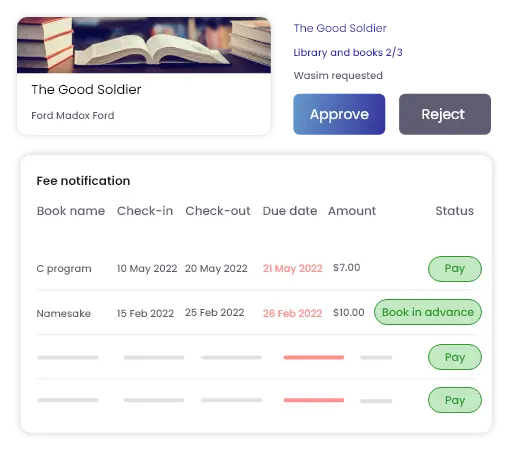
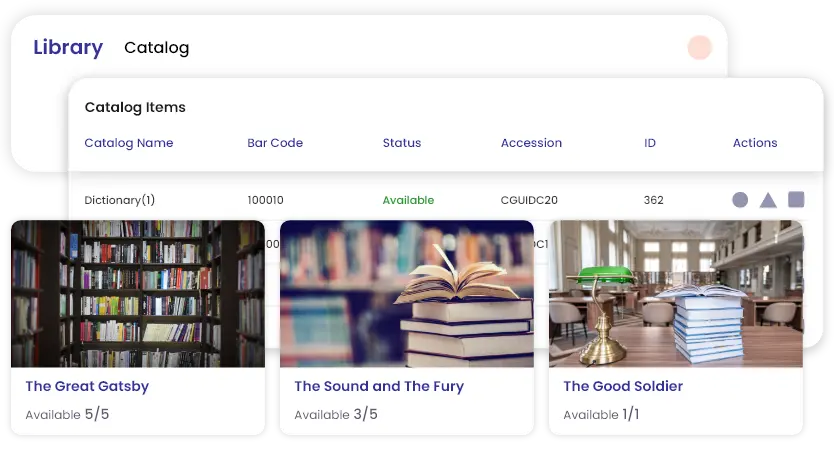
One-click-membership
Boost member engagement with a web-based library management system that can be easily accessed from anywhere, at any time. Creatrix Online Public Access Catalog - OPAC library software system allows users to easily search books by applying various filter options!
The versatile platform has all the modern communication and control systems you would look for in college libraries. Users can register, create profiles and access information and navigate across the system easily.
Do more with Creatrix:
- Automatic online cataloging of resources
- Updates and backups data on time
- Outlines secure and reliable library operations

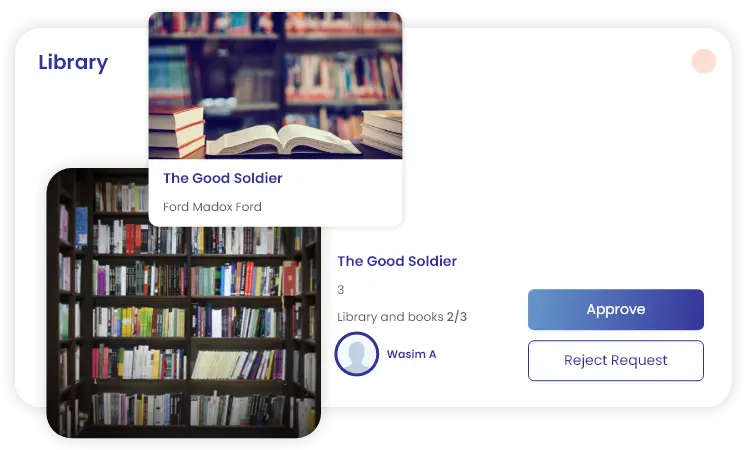
Requests, renewals, and circulations
Enjoy full cataloging, circulation, and acquisitions from our library software. Configure circulation rules and manage resources issued to students, transactions, membership, fine calculation of return items, etc.
Harness the knowledge resources to discover, learn and interact using our simple yet powerful library automation software. Users can view the books borrowed, place the books on hold, request or renew, and view overdue books return and fines/invoices.
Do more with Creatrix:
- Easy stock verification in real-time
- Set book issue limit for all users
- Trigger due reminders to students for submission
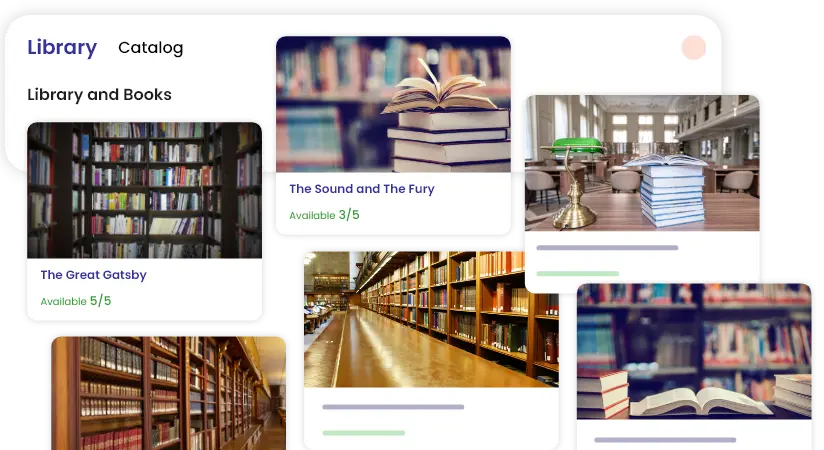
Instant acquisition and cataloging
Simplify library duties by maintaining an accurate database for cataloging and enjoy a high level of precision over subscriptions, renewals, and cancellations! Indulge in requests for proposals, quotation comparisons, purchase orders, invoicing, and much more.
Automate the entire procurement process and new materials acquisition such as books, periodicals, and other equipment. Gain control to monitor budgets, reconcile invoices and approve payments to suppliers.
Do more with Creatrix:
- Review and monitor library operations
- Generate ID cards and manage subscriptions
- Identify, track and maintain an inventory

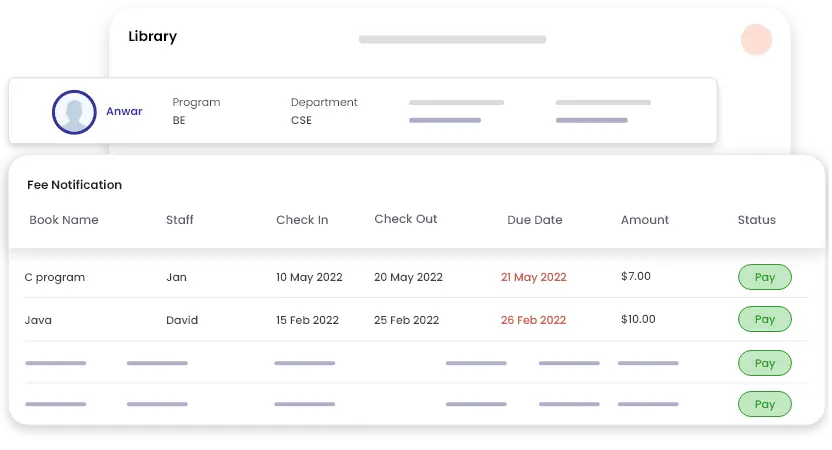
Automated fee collection
Meet the needs of both modern and traditional librarians and deliver timely, accurate data with a complete library automation system. Our Library software is highly flexible and lets librarians configure multiple library fee type structures and payment collection methods.
Efficiently track fee receipts for various periods. Calculate late returns and set up fine rates for items damaged, broken, or lost. Create receipts for student online fee payments.
Do more with Creatrix:
- Manage late returned, lost/damaged books
- Generate multiple fee-related reports
- Maintains data safe and secured in a cloud
What is a college Library Management System?
A library management system is software with high-end automation features that specifically control every aspect of a library. It streamlines all aspects of the library's operations and reduces repetitive manual and error-prone tasks.
The software automates crucial tasks of handling book purchases, fine handling, cataloging, indexing, circulation recording, stock checking, etc. It is now easy to add new books, remove old books, and update the member and book databases.
The system can keep track of the books that are checked out, returned, lost, or misplaced. It has the intelligence to keep track of the membership information, send automatic overdue fine calculations and notify defaulters.
What are the key features of a Library Management System?
Common features of a Library Management System include:
- Book cataloging and classification
- Member registration and management
- Circulation management (check-in, check-out, renewals)
- Reservations and holds
- Fine and overdue management
- Acquisitions and procurement
- Interlibrary loan management
- Reporting and analytics
- Integration with external databases and systems
How does a Library Management System benefit the library?
A Library Management System offers several benefits to libraries, including:
- Efficient cataloging and organization of books, making them easily searchable and accessible to library users.
- Streamlined circulation processes, ensuring smooth check-ins, check-outs, and renewals.
- Member management, including registration, tracking borrowing history, and managing fines and penalties.
- Improved inventory management, helping libraries track books, acquisitions, and availability.
- Enhanced reporting and analytics for better decision-making and resource allocation.
- Integration with external databases and systems, facilitating access to additional resources and services.
Can a Library Management System handle multiple branches or libraries?
Yes, many Library Management Systems are designed to handle multiple branches or libraries. They provide options to create and manage different branches within the system, allowing administrators to track books, members, and activities separately for each location.
Is it possible to integrate a Library Management System with other systems?
Yes, integration with other systems is possible depending on the capabilities and flexibility of the Library Management System. Integration with systems such as student information systems, digital resource platforms, or online catalogs can streamline data exchange and provide a seamless experience for library users.
How secure is the data in a Library Management System?
Data security is an important aspect of any software system, including a Library Management System. These systems employ security measures such as encryption, user authentication, access controls, and regular backups to ensure data protection. It's essential to choose a reputable system provider that prioritizes data security and complies with relevant regulations.
Can a Library Management System generate reports?
Yes, Library Management Systems typically provide reporting and analytics features. These systems can generate various reports related to book circulation, member activity, overdue items, acquisitions, and more. The reports offer valuable insights for library administrators to evaluate performance and make informed decisions.
How easy is it to learn and use a Library Management System?
The ease of learning and using a Library Management System can vary depending on the specific system and its user interface. However, modern systems are designed with user-friendliness in mind, offering intuitive interfaces and straightforward workflows. Training and support materials are usually provided by the system provider to assist library staff in effectively utilizing the system.
Can students access the Library Management System?
Yes, many Library Management Systems provide a patron portal or mobile application for library users to access relevant information and perform tasks such as searching for books, placing holds, renewing loans, and checking their borrowing history. The system's access privileges can be configured to ensure appropriate levels of data security and privacy.
Is it possible to customize a Library Management System?
Customization options may vary depending on the system provider. Some providers offer flexibility to customize certain aspects of the system, such as adding custom fields, defining loan policies, or integrating with specific external services. It's recommended to discuss customization requirements with the system provider to understand the available options.














